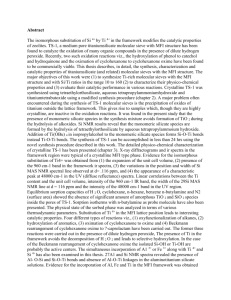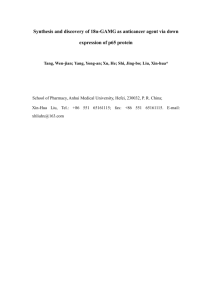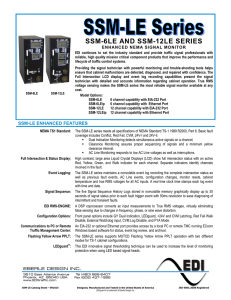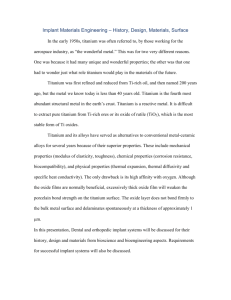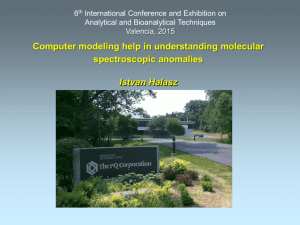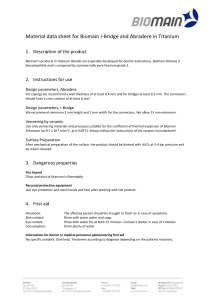Structural and Superacidity Study of Bifunctional Catalyst, Sulfated- Titanium/TS-1
advertisement
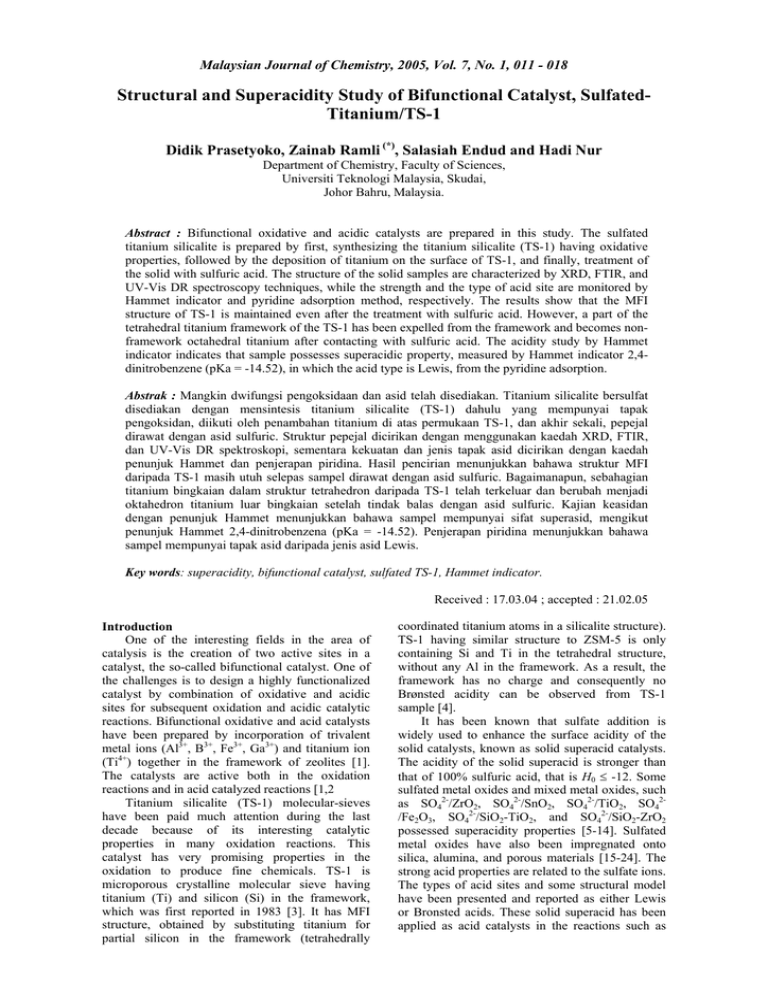
Malaysian Journal of Chemistry, 2005, Vol. 7, No. 1, 011 - 018 Structural and Superacidity Study of Bifunctional Catalyst, SulfatedTitanium/TS-1 Didik Prasetyoko, Zainab Ramli (*), Salasiah Endud and Hadi Nur Department of Chemistry, Faculty of Sciences, Universiti Teknologi Malaysia, Skudai, Johor Bahru, Malaysia. Abstract : Bifunctional oxidative and acidic catalysts are prepared in this study. The sulfated titanium silicalite is prepared by first, synthesizing the titanium silicalite (TS-1) having oxidative properties, followed by the deposition of titanium on the surface of TS-1, and finally, treatment of the solid with sulfuric acid. The structure of the solid samples are characterized by XRD, FTIR, and UV-Vis DR spectroscopy techniques, while the strength and the type of acid site are monitored by Hammet indicator and pyridine adsorption method, respectively. The results show that the MFI structure of TS-1 is maintained even after the treatment with sulfuric acid. However, a part of the tetrahedral titanium framework of the TS-1 has been expelled from the framework and becomes nonframework octahedral titanium after contacting with sulfuric acid. The acidity study by Hammet indicator indicates that sample possesses superacidic property, measured by Hammet indicator 2,4dinitrobenzene (pKa = -14.52), in which the acid type is Lewis, from the pyridine adsorption. Abstrak : Mangkin dwifungsi pengoksidaan dan asid telah disediakan. Titanium silicalite bersulfat disediakan dengan mensintesis titanium silicalite (TS-1) dahulu yang mempunyai tapak pengoksidan, diikuti oleh penambahan titanium di atas permukaan TS-1, dan akhir sekali, pepejal dirawat dengan asid sulfuric. Struktur pepejal dicirikan dengan menggunakan kaedah XRD, FTIR, dan UV-Vis DR spektroskopi, sementara kekuatan dan jenis tapak asid dicirikan dengan kaedah penunjuk Hammet dan penjerapan piridina. Hasil pencirian menunjukkan bahawa struktur MFI daripada TS-1 masih utuh selepas sampel dirawat dengan asid sulfuric. Bagaimanapun, sebahagian titanium bingkaian dalam struktur tetrahedron daripada TS-1 telah terkeluar dan berubah menjadi oktahedron titanium luar bingkaian setelah tindak balas dengan asid sulfuric. Kajian keasidan dengan penunjuk Hammet menunjukkan bahawa sampel mempunyai sifat superasid, mengikut penunjuk Hammet 2,4-dinitrobenzena (pKa = -14.52). Penjerapan piridina menunjukkan bahawa sampel mempunyai tapak asid daripada jenis asid Lewis. Key words: superacidity, bifunctional catalyst, sulfated TS-1, Hammet indicator. Received : 17.03.04 ; accepted : 21.02.05 Introduction One of the interesting fields in the area of catalysis is the creation of two active sites in a catalyst, the so-called bifunctional catalyst. One of the challenges is to design a highly functionalized catalyst by combination of oxidative and acidic sites for subsequent oxidation and acidic catalytic reactions. Bifunctional oxidative and acid catalysts have been prepared by incorporation of trivalent metal ions (Al3+, B3+, Fe3+, Ga3+) and titanium ion (Ti4+) together in the framework of zeolites [1]. The catalysts are active both in the oxidation reactions and in acid catalyzed reactions [1,2 Titanium silicalite (TS-1) molecular-sieves have been paid much attention during the last decade because of its interesting catalytic properties in many oxidation reactions. This catalyst has very promising properties in the oxidation to produce fine chemicals. TS-1 is microporous crystalline molecular sieve having titanium (Ti) and silicon (Si) in the framework, which was first reported in 1983 [3]. It has MFI structure, obtained by substituting titanium for partial silicon in the framework (tetrahedrally coordinated titanium atoms in a silicalite structure). TS-1 having similar structure to ZSM-5 is only containing Si and Ti in the tetrahedral structure, without any Al in the framework. As a result, the framework has no charge and consequently no Brønsted acidity can be observed from TS-1 sample [4]. It has been known that sulfate addition is widely used to enhance the surface acidity of the solid catalysts, known as solid superacid catalysts. The acidity of the solid superacid is stronger than that of 100% sulfuric acid, that is H0 ≤ -12. Some sulfated metal oxides and mixed metal oxides, such as SO42-/ZrO2, SO42-/SnO2, SO42-/TiO2, SO42/Fe2O3, SO42-/SiO2-TiO2, and SO42-/SiO2-ZrO2 possessed superacidity properties [5-14]. Sulfated metal oxides have also been impregnated onto silica, alumina, and porous materials [15-24]. The strong acid properties are related to the sulfate ions. The types of acid sites and some structural model have been presented and reported as either Lewis or Bronsted acids. These solid superacid has been applied as acid catalysts in the reactions such as 012 Zainab Ramli Structural and Superacidity Study of Bifunctional Catalyst, Sulfated-Titanium/TS-1 isomerization, cracking, alkylation, acylation, and esterification [9-14, 19-24]. Here, we studied the structure and acidity of bifunctional oxidative and acidic catalysts, prepared by treatment of the TS-1 microporous materials with sulfate ion. The tetrahedral titanium in the TS-1 acts as an oxidative site, while the acid site is created by the addition of sulfate ion. The structure and properties of catalysts are characterized using XRD, FTIR and UV-Vis DR spectroscopies. The acid strength of the solids is measured by Hammet indicators technique, while the type of acid is determined by pyridine adsorption which is monitored by FTIR technique. of TEOT in the surface of TS-1 was performed in the neutral condition by adding 10 ml of water, with stirring at room temperature for 24 hrs. The solid was dried at 100oC for 24 hrs (Ti/TS-1). The Ti/TS-1 was added slowly into the sulfuric acid solution (10 ml, 0.5 M, Merck, 99%), and stirred at room temperature for 1 hr. The solid was separated from the liquid by centrifugation, followed by washing with water until neutral pH. Finally, the solid was dried at 100oC for 24 hrs and calcined at 550oC for 5 hrs. The resulting sample was denoted as SO42--Ti/TS-1. Table 1 summarizes the chemical composition of the samples and the preparation method. Experimental Characterization The solid structure was determined by using XRD, infrared and UV-Vis DR spectroscopy techniques. All molecular-sieves were characterized by powder X-ray diffraction (XRD) Preparation of sample TS-1 (2% of Titanium, %mol) was prepared according to a procedure described earlier [3, 25], Table 1 : Initial titanium compositions and properties of the samples Intensity, Titanium (*) Titanium (#) Sample Td, %wt Oh, %wt Cps (XRD) Td, % λ, nm H-ZSM-5 - - - - - TS-1 2 - 2400 100 208 SO4/TS-1 2 2380 51 228 SO4-Ti/TS-1 2 2254 67 215 1.7 (*) Composition of titanium in the initial mixture (#) Based on UV-Vis DR data using reagents i.e. tetraethyl orthosilicates (Merck, 98%), tetraethylorthotitanate (Merck, 95%) in isopropyl alcohol, tetrapropylammonium hydroxide (Merck, 20% TPAOH in water), and distilled water. The hydrothermal crystallization was carried out at 175oC under static condition in the stainless steel autoclave for 4 days. Sulfated TS-1 was prepared by impregnation method as follows: About 1 g of TS-1 was added into 25 ml of H2SO4 0.5 M under vigorous stirring at 80oC for 3 hrs. After evaporation of water, the solid was dried at 100oC for 24 hrs. The solid sample was then calcined at 550oC for 3 hrs. The sample was denoted as SO4/TS-1. Sulfated titanium TS-1 was prepared by impregnation of titanium on TS-1 using tetraethylorthotitanate, TEOT as precursor, followed by hydrolysis using water, and finally titanium TS-1 was treated with sulfate ion. For 1wt.% of Ti loaded TS-1, pre-dried of assynthesized TS-1 sample (0.83 g) was added into the solution of TEOT (0.073 g, Merck, 95%) in isopropanol (10 ml, Merck, 98%). The mixture was stirred at room temperature for 3 hrs, followed by evaporation of the solvent at 80oC. The hydrolysis for the crystallinity and phase content of the solid materials using a Bruker Advance D8 Difractometer with the Cu Kα (λ=1.5405 Å) radiation as the diffracted monochromatic beam at 40 kV and 40 mA. The sample was scanned in the 2θ range between 5o to 50o at a step 0.020o and step time 1s (scanning speed of 1.2o/min). Infrared (IR) spectra of the samples were collected on a Perkin Elmer Fourier Transform Infrared (FTIR), with a spectral resolution of 2 cm-1, scans 10 s, at temperature 20oC by KBr pellet method. The framework spectra were recorded in the region of 1400 – 400 cm-1.Diffuse reflectance UV-visible (UV-vis DR) spectra were recorded under ambient conditions on a Perkin Elmer Lambda 900 UV/VIS/NIR spectrometer. The acid strength of the solids were measured by Hammet indicators. The sample (0.05 g) was heated under nitrogen flow (40 cc/min) at 400oC for 15 minutes and cooled down to 200oC. The sample was taken out and added into the solution of benzene (Merck, 99%) containing Hammet indicators immediately and the color of indicator with different pKa were observed. The types of acid sites were characterized by absorbed base probe molecule. The wafer of the sample (10- 013 Zainab Ramli Structural and Superacidity Study of Bifunctional Catalyst, Sulfated-Titanium/TS-1 12 mg) was locked in the cell equipped with CaF2 windows, and evacuated at 400oC under vacuum condition for 4 hrs. Pyridine as probe molecule was introduced into the evacuated sample at room temperature. Infrared spectra of the sample were monitored at room temperature after desorption of pyridine at 150oC for 1 hr. Results and discussion Structure characterization XRD was used to characterize the structure and the crystallinity of the samples. Figure 1 shows the XRD patterns of the samples, while Table 1 shows the highest peak of each sample, at 2θ = 7.9o. Generally, all samples show similar XRD pattern characteristic of MFI structure type of zeolite. Introduction of SO42- anions into the TS-1 and titanium impregnated TS-1 (SO42-/TS-1 and SO42-Ti/TS-1 samples) has insignificant effect to crystallinity of the sample, with less than 1% changes. In addition, no significant peaks shifting can be observed in all TS-1 treated samples. This finding suggests that the MFI structure of TS-1 is maintained after the introduction of SO42- and SO42-Ti. Figure 2 shows FTIR spectra of the samples. TS-1 sample show five peaks at ca. 1230, 1100, 800, 550 and 450 cm-1, characteristic for MFI type of zeolites [26]. A peak at ca. 970 cm-1 is observed which is characteristic for titanium with tetrahedral structure [27, 28]. The analogues sample of TS-1, the silicalite MFI containing only silica in the framework does not show any band at around this frequency. In addition, the impregnated Ti on silicalite (1wt.% of Ti) also does not show the band around 970 cm-1, i.e. no additional band appears after the impregnation of titanium. Impregnation of SO42- and SO42--Ti into the TS-1 shows that all the characteristic peaks vibration for TS-1 is maintained with good intensities. However, the peak intensity for the tetrahedral titanium at ca. 970 cm-1 decreased after impregnation with SO42 or SO42--Ti on TS-1, indicating that the amount of Intensities, cps TS-1 SO42-/TS-1 SO42--Ti/TS-1 10 20 30 2θ, degree 40 Figure 1 :. XRD pattern of the samples 50 014 Zainab Ramli Structural and Superacidity Study of Bifunctional Catalyst, Sulfated-Titanium/TS-1 H-ZSM-5 TS-1 SO42-/TS-1 SO42--Ti/TS-1 1384 S=O, SO42- 1400 1200 1000 800 Wavenumber, cm-1 600 400 Figure 2 : FTIR spectra of the samples tetrahedral titanium has decreased. In addition, a new peak at ca. 1384 cm-1 is observed, which corresponds to the asymmetric stretching vibration of the covalent S=O for SO42- ion. This peak is considered as characteristic band of SO42- on promoted superacid [6, 14]. This finding indicates that the MFI structure of TS-1 sample is not collapsed after the treatment with sulfuric acid in order to introduce the SO42- anions. This observation can be seen in samples SO42-/TS-1 and SO42--Ti/TS-1. UV-Vis DR spectroscopy was used to monitor the titanium structure in the samples. The ultraviolet peak position of the Ti ion depends essentially on its coordination and on the size of extra-framework TiO2 particles whenever present in the sample. The band in the range of 190-220 nm is attributed to a charge transfer of the tetrahedral titanium (Td) sites between O2- and the central Ti(IV) atoms, while octahedral Ti (Oh) is observed at ca. 260-330 nm [27, 29]. Figure 3 shows that, for TS-1 sample, only single high intense band at around 208 nm is observed. This band is attributable for titanium in the tetrahedral structure. This finding further support that TS-1 contains Ti in the tetrahedral structure. As for SO42-/TS-1 and SO42--Ti/TS-1 samples, a medium intense band at ca. 215 - 228 nm and a shoulder band at ca. 270 312 nm are observed, which are characteristic for titanium with tetrahedral and octahedral structures, respectively. The intensity of tetrahedral titanium for both samples has decreased as compared 015 Zainab Ramli Structural and Superacidity Study of Bifunctional Catalyst, Sulfated-Titanium/TS-1 208 5.5 4.5 215 Intensities, K-M SO42-Ti/TS-1 3.5 228 SO42-/TS-1 289 2.5 TS-1 270 1.5 H-ZSM-5 0.5 200 250 300 350 400 450 500 550 600 Wavelength, nm Figure 3 : UV-Vis DR spectra of the samples to parent sample TS-1, in which the tetrahedral titanium intensity for SO42--Ti/TS-1 sample is significantly higher than SO42-/TS-1 sample. The decrease in the intensity of the tetrahedral titanium band followed by the formation of the octahedral titanium band clearly indicates that some of the tetrahedral titanium framework has been expelled from the framework, and becomes extraframework titanium, with octahedral structure. The oxidation activity depends on the amount of titanium in the tetrahedral structure [27]. The purpose of deposition of the titanium in the TS-1 is to add the extraframework titanium on the TS-1 surface such that the SO42- anion only react with the titanium extraframework on the surface of TS-1 instead of tetrahedral titanium of TS-1. Thus, we would expect the spectrum of UV-Vis DR for this sample would give a band for tetrahedral titanium with similar intensity as for the TS-1. Table 1 shows the percentage of tetrahedral titanium in the samples (calculated based on the intensity of tetrahedral titanium in TS-1, in which TS-1 is taken as 100%) and also the position of the band. The results from the UV-Vis DR spectrum show that the intensity of the band for tetrahedral titanium species of SO42--Ti/TS-1 sample is lower than that of TS-1 sample, and shift to the higher wavelength to about 215 nm. Meanwhile, for the SO42-/TS-1 sample, its intensity is much lower than that of TS1 sample, and also shifts to the higher wavelength to about 228 nm. The shifting of the band to higher wavelength suggests that the SO42- anions has reacted with the tetrahedral titanium in both samples. However, the amount of tetrahedral titanium which has been reacted with SO42- anion is lower for SO42--Ti/TS-1 sample as compared to the SO42-/TS-1 sample. It indicates that for sample SO42--Ti/TS-1, the SO42- anion has reacted not only with the tetrahedral titanium but also with the titanium extraframework (which is in the octahedral structure) on the surface of TS-1. The band shifting in the range of tetrahedral titanium of the SO42-/TS-1 and SO42--Ti/TS-1 samples to higher wavelength at ca. 228 and 215 nm shows that the charge transfer of the tetrahedral titanium sites between O2- and the Ti(IV) atoms for both samples is lower than that of the TS-1. This finding indicates that the oxygen atom in the tetrahedral titanium which has charge transfer of O(2p) → Ti(3d) is bonded with the sulfur atom in the form of SO42-. The electronegativity of the sulfur atom (2.58, Pauling unit) is higher than that of silicon atom (1.90, Pauling unit). Therefore, for SO42-/TS-1 and SO42--Ti/TS-1 samples, electron 016 Zainab Ramli Structural and Superacidity Study of Bifunctional Catalyst, Sulfated-Titanium/TS-1 density in the oxygen atom decreases, consequently, the charge transfer energy of O(2p) → Ti(3d) decreases, compare to TS-1 sample. As a result, the tetrahedral titanium band shifted to the higher wavelength (lower energy) in the UV-Vis DR spectroscopy. Acidity studies The acid strength of the sample was measured by observing the changing of the color of Hammet indicators [5], when the dried solid sample was poured into the solution of the indicator in benzene. Table 2 shows the acidic strength of the samples measured by Hammet indicators. H-ZSM-5 sample is found to have an H0 value around –11.35 (measured in 1-nitrotoluene), in which the strength is similar with 98% of sulfuric acid. The TS-1 sample does not show any color changing of all Hammet indicators up to the pKa = -5.6 (measured in benzalacetophenone), indicating that the samples have low acid strength. Meanwhile, the SO42-/TS-1 and SO42--Ti/TS-1 samples show color changing for all Hammet indicators, including measured in 2,4-dinitrobenzene (pKa = -14.52). This result suggests that both samples contain superacidity. The type of acid sites of the samples were monitored by pyridine adsorption after evacuation of the samples at 400oC under vacuum, followed by adsorption of pyridine at room temperature, and evacuation at 150oC for an hour under vacuum. Samples were recorded by FTIR spectroscopy at room temperature in the range wavenumber of 2000 – 1400 cm-1. The main peaks at ca. 1450 cm-1 and 1545 cm-1 are characteristic for Lewis and Brønsted acid sites, respectively. While the peak at ca. 1880 cm-1 is characteristic for vibration of the titanium silicalite framework. Figure 4 shows the spectra of the samples after evacuation at 150oC. All samples only show the peak at ca. 1445 cm-1 which corresponds to Lewis acid sites, while the peak for Brønsted acid sites at ca. 1545 cm-1 was not observed. This finding indicates that all samples only contain Lewis acid sites. The amount of the acid sites increase in sample SO42--Ti/TS-1 after the Ti loaded on the surface of TS-1 was treated by sulfuric acid. It has been reported that the introduction of sulfate anions on the surface of zirconia has been found to increase the number and strength of the Lewis acid sites. It has been proposed that superacid sites of the sulfated oxides material such as zirconia is formed via oxidation of zirconia hydroxide in the presence of sulfate ion at high temperature, regardless of the types of starting materials used for sulfation [14]. It has further been suggested that such a structure may develop at the edge or corner of the metal oxide surfaces. In this study, for the samples SO42-/TS-1 and SO42--Ti/TS1, based on the characterization results especially the UV-Vis DR spectroscopy technique, the proposed structure of sulfated titanium on TS-1 is shown in Figure 5. The SO42- ion is bonded with the titanium framework and titanium extraframework. Table 2 : Acid strength by Hammet indicator Hammet pKa of Indicator indicator (*) Sample H2SO4 H- TS-1 ZSM-5 SO42- SO42--Ti /TS-1 /TS-1 1 -5.60 + + - + + 2 -8.20 + + - + + 3 -11.35 + + - + + 4 -12.70 - - - + + 5 -13.75 - - - + + 6 -14.52 - - - + + (*) 1=Benzalacetophenone; 4=1-chloro 4-nitrobenzene; 2=Anthraquinone; 3=1-nitrotoluene; 5=2,4-dinitrotoluene; 6=2,4-dinitrofluorobenzene 017 Zainab Ramli Structural and Superacidity Study of Bifunctional Catalyst, Sulfated-Titanium/TS-1 Absorbance TS-1 SO42-/TS-1 SO42--Ti/TS-1 2000 1900 1800 1700 1600 Wavenumber, cm-1 1500 1400 Figure 4 : FTIR spectra of the samples after following treatments: heated at 400oC for 4 hrs in vacuum, adsorbed pyridine at room temperature, and desorbed pyridine at 150oC for an hour. O O S O O Ti O O S HO OH O O O O 4+ Si Ti Si Ti extraframework Ti framework (SO42--Ti/TS-1) (SO42-/TS-1) Figure 5 : Proposed structure of the sulfated titanium on TS-1 Conclusions Bifunctional oxidative and superacid catalysts have been prepared. The SO42-/TS-1 and SO42-Ti/TS-1 samples showed both oxidative and acidic sites. The amount of oxidative site is higher for SO42--Ti/TS-1 sample than of SO42-/TS-1 sample, while the superacid strength is similar in both samples. However, creation of superacid sites caused the decrease in the oxidative sites. Acknowledgements We gratefully acknowledge funding from The Ministry of Science Technology and Environment Malaysia, under IRPA grant no: 09-02-06-0057 SR0005/09-03. References 1. Trong On., D., Nguyen, S.V., Hulea, V., Dumitriu, E. and Kaliaguine, S. (2003) Microporous and Mesoporous Mater, 57, 169– 180. 018 2. 3. 4. 5. 6. 7. 8. 9. 10. 11. 12. 13. 14. 15. Zainab Ramli van der Waal, J.C., Rigutto, M.S. and van Bekkum, H. (1998) Appl. Catal. A: General, 167, 331-342. Taramasso, M., Perego, G. and Notari, B. (1983) US Patents No., 4,410,501. Dias, S.C.L. (1997) Characterization of zeolites and zeotypes. PhD Thesis, University of Florida. Yang, H., Lu, R., Zhao, J., Yang, X., Shen, L. and Wang, Z. (2003) Mater. Chemistry and Physics, 80, 68–72. Jung, S. M., Dupont, O. and Grange, P. (2001) Appl. Catal. A: General, 208, 393-401. Huang, Y., Zhao, B. and Xie, Y. (1998) Appl. Catal. A: General, 171, 75-83. Miao, C.X. and Gao, Z. (1997) Mater. Chemistry and Physics, 50, 15–19. Matsuhashi, H., Miyazaki, H., Kawamura, Y., Nakamura, H. and Arata, K. (2001) Chem. Mater, 13, 3038-3042. Arata, K. (1996) Appl. Catal. A: General,146, 3-32 . Das, D., Mishra, H.K., Dalai, A.K. and Parida, K.M. (2003) Appl. Catal. A: General, 243, 271–284. Moreno, J.A. and Poncelet, G. (2001) Appl. Catal. A: General, 210, 151-164 Grau, J.M., Vera, C.R. and Parera, J.M. (1998) Appl. Catal. A: General, 172, 311-326. Yadav, G.D. and Nair, J.J. (1999) Microporous and Mesoporous Mater, 33, 1-48. Huang, Y., Zhao, B. and Xie, Y. (1998) Appl. Catal. A: General, 173, 27-35. Structural and Superacidity Study of Bifunctional Catalyst, Sulfated-Titanium/TS-1 16. Huang, Y., Zhao, B. and Xie, Y. (1998) Appl. Catal. A: General, 171, 65-73. 17. Huang, Y., Zhao, B. and Xie, Y. (1998) Appl. Catal. A: General, 172, 327-331. 18. Damyanova, S., Grange, P. and Delmon, B. (1997) J. Catal., 168, 421-430. 19. Lei, T., Xu, J.S., Tang, Y., Hua, W.M. and Gao, Z. (2000) Appl. Catal. A: General, 192, 181–188. 20. Sohn, J.R. and Seo, D.H. (2003) Catal. Today, 87, 219–226. 21. Arata, K. and Hino, M. (1990) Appl. Catal., 59, 197-204. 22. Clearfield, A., Serrette, G.P.D. and KhaziSyed, A.H. (1994) Catal. Today, 20, 295-312 23. Hua, W., Goeppert, A. and Sommer, J. (2001) J. Catal., 197, 406-413. 24. Xia, Q.-H., Hidajat, K. and Kawi, S. (2000) Chem. Commun., 2229–2230. 25. van der Pol, A.J.H.P., Verduyn, A.J. and van Hooff, J.H.C. (1992) Appl. Catal. A: General, 92, 113-130. 26. Flanigen, E. M. (1976) in Rabo, J.A. “Zeolite chemistry and catalysis”. ACS Monograph, 171, 80-117. 27. Zecchina, A., Bordiga, S., Lamberti, C., Ricchiardi, G., Lamberti, C., Ricchiardi, G., Scarano, D., Petrini, G., Leofanti, G. and Mantegazza, M. (1996) Catal. Today, 32, 97106. 28. Smirnov, K.S. and van de Graaf, B. (1996) Microporous Mater, 7, 133-138. 29. Astorino, E., Peri, J.B., Willey, R.J. and Busca, G. (1995) J. Catal., 157, 482-500.
